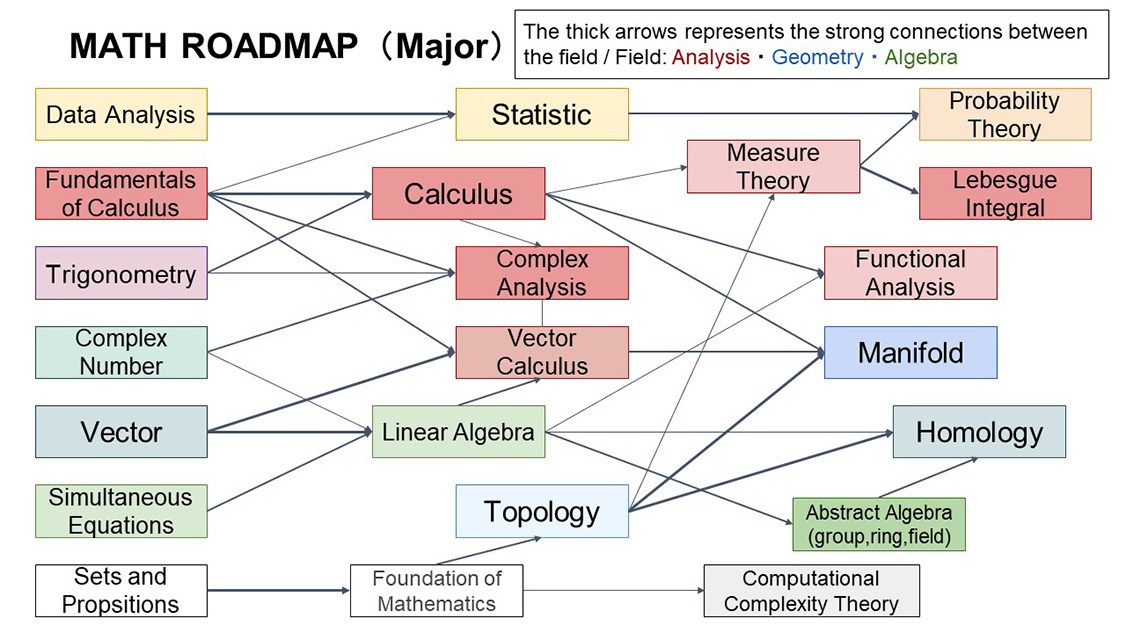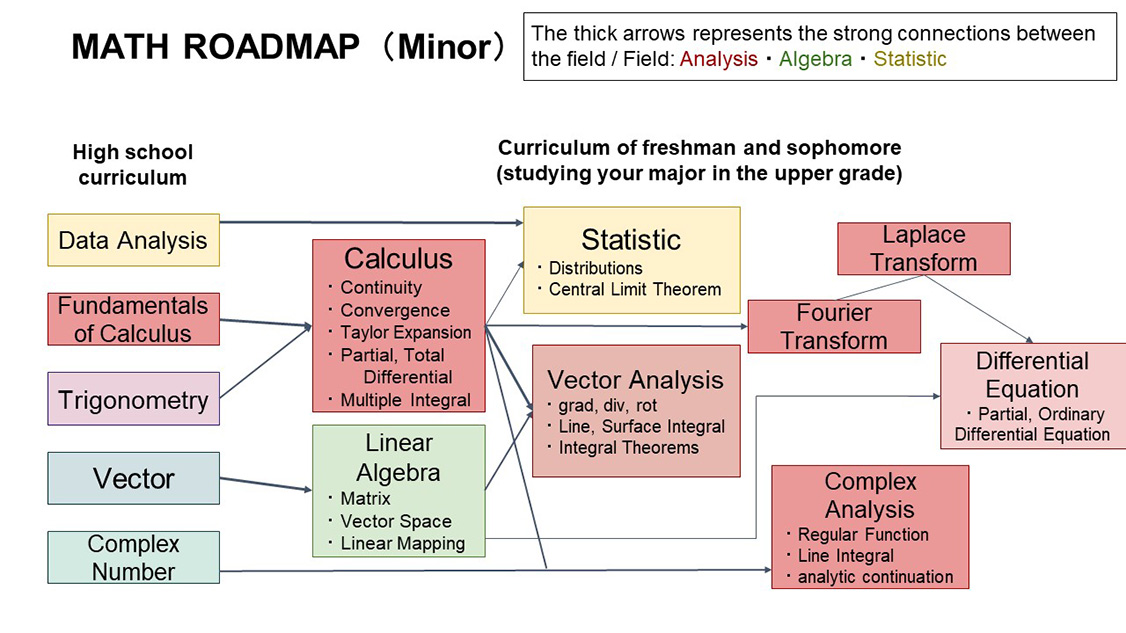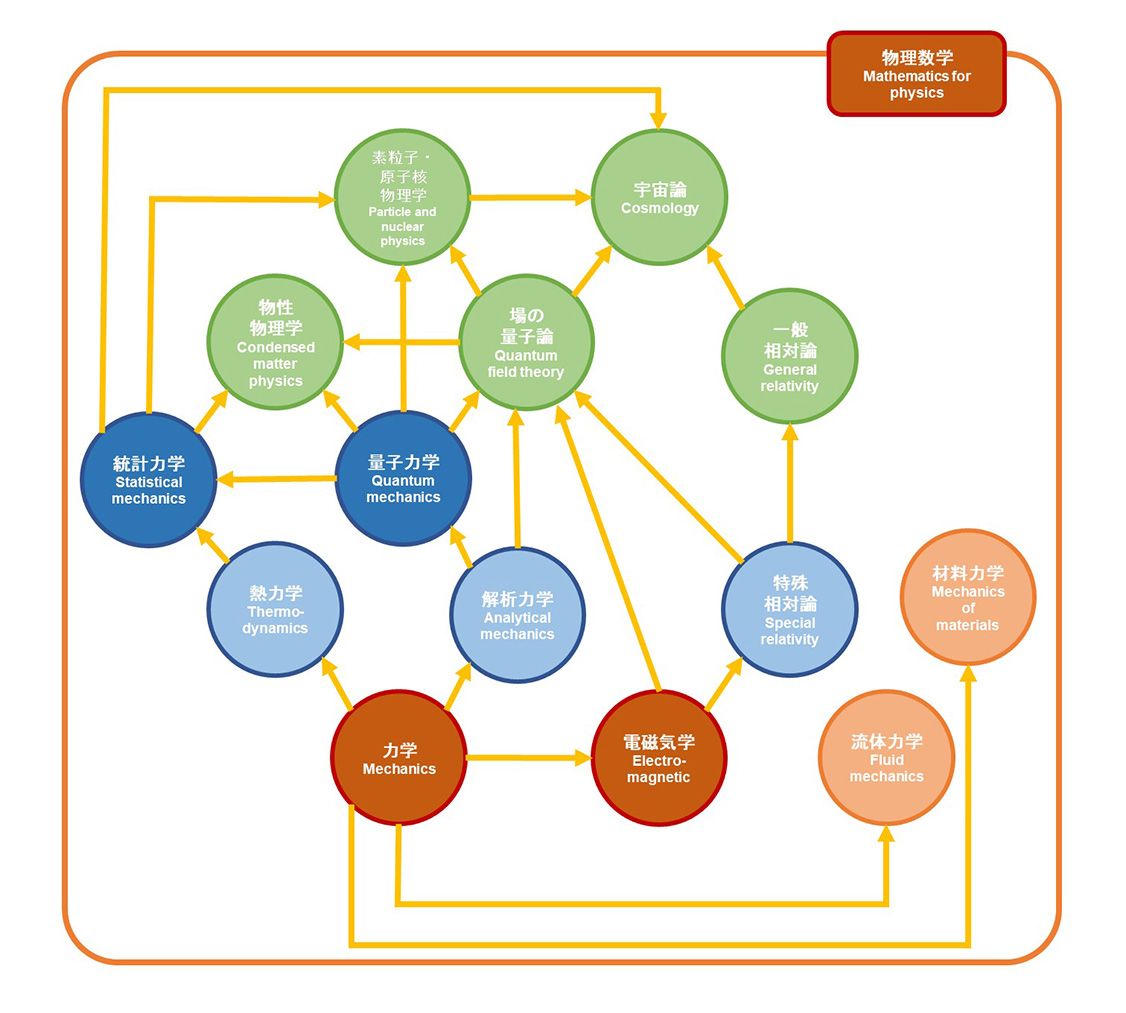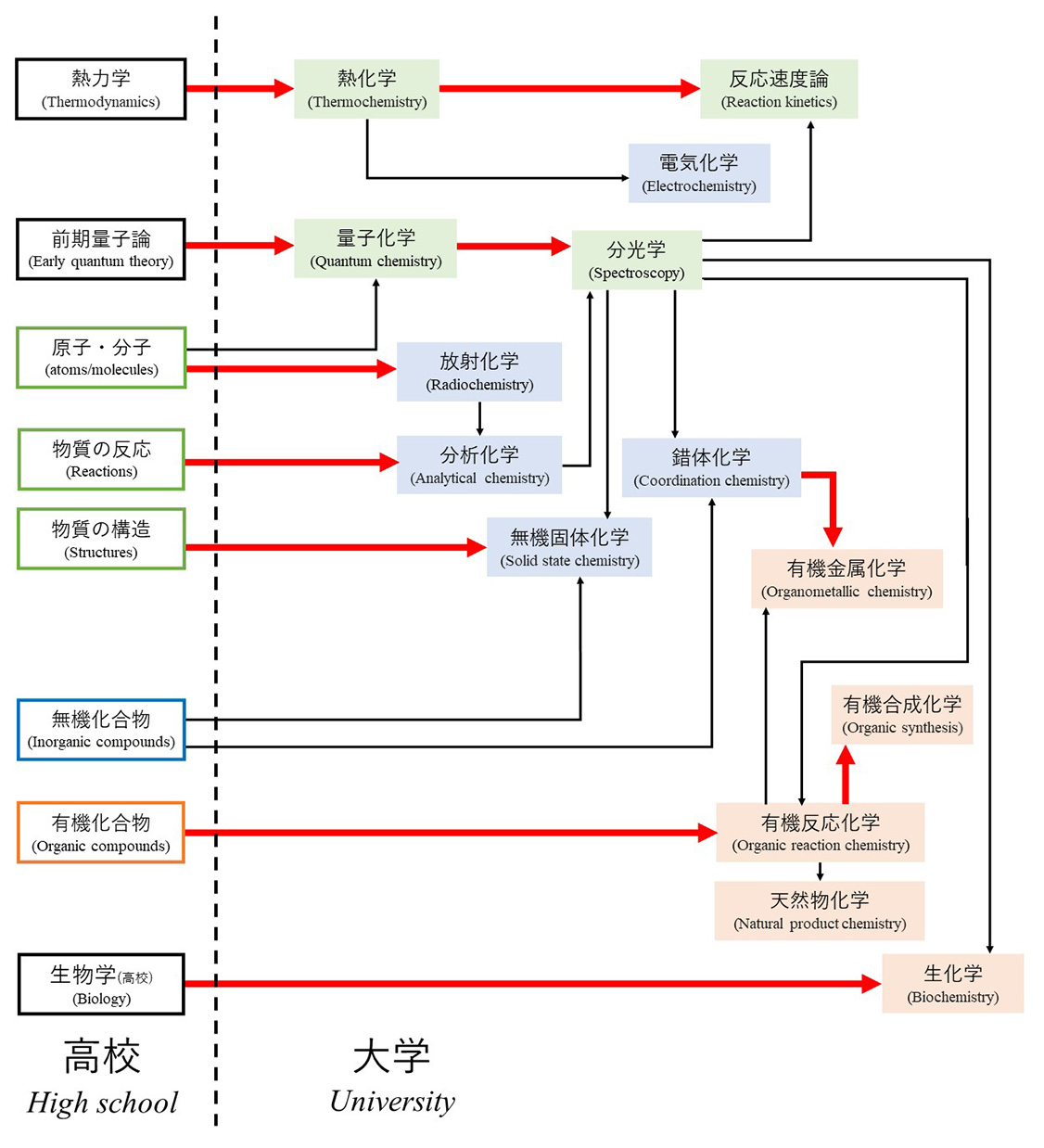Learning in University
目次
Science Subjects
Mathematics
-
TIP 01
Check for unfamiliar symbols and terms
- In college mathematics, you will encounter unfamiliar symbols and unique wording. Even if you can actually understand the content, if you do not know the meaning of the symbols and phrases, you will not be able to understand the whole subject. For unfamiliar symbols and phrases, look them up in your textbook or ask questions of your teachers or friends to make sure you understand them correctly.
-
TIP 02
Consider simple examples.
- Theorems are often stated in abstract and general forms. Try to get a general idea of what a theorem means by applying it to a function or set that you know well.
-
TIP 03
Understand the theorem by connecting it to your existing knowledge.
- In order to better understand the meaning of a theorem, try to connect what you are learning with what you already know.
-
TIP 04
Understand that the assertion of the theorem is natural and inevitable
- Once you have grasped the meaning of a theorem, consider how it was constructed, i.e., “What did you want to do that led you to think that way?” Once you can see this, you will be able to use the theorem as your own tool.
-
TIP 05
Visualize the theorem as much as possible
-
Once you have grasped the meaning of the theorem, try to put the image in your mind on paper and represent it in a
graph or diagram. By doing so, you can better realize the naturalness and inevitability of the
theorem.
However, it is often impossible to accurately visualize highly abstract content. Therefore, keep your visualization to images only and be careful not to use your visualization as a logical basis. -
TIP 06
Organize specific calculations
- In college mathematics, it is often difficult to perform specific calculations simply by looking at definitions. Therefore, in parallel with understanding definitions and theorems, it is important to organize in your own way what you need to do in order to perform specific calculations.
Cross-Disciplinary Connections in Mathematics Subjects


Physics
-
TIP 01
Learning with Images (Phenomena)
-
The learning goal of physics is “to be able to explain natural phenomena universally. Therefore, it is important
to create what is happening as a natural phenomenon, not just to follow mathematical formulas.
When the content is too abstract to visualize, try applying it to concrete examples learned in high school physics. It can also help to visualize the problem settings and the results of the calculations, and to look for easy-to-understand images and videos on the Internet. -
TIP 02
Math is important.
- University physics heavily uses mathematics as a tool for abstraction. Among those who struggle with physics, many actually stumble over the mathematical content. Therefore, it’s crucial to get physics mathematics to a “usable” state first. Before detailed proofs, it’s essential to visually grasp the concept of the formulae.
-
TIP 03
Do the Calculations Yourself.
- Perform the calculations you encounter in class or textbooks yourself. Even if you think you “understand” after hearing an explanation or reading, actually doing the calculations can reveal misunderstandings. Calculations can also help clarify the physical image. Here are two specific methods:
①Consider “Extreme Cases”
There are many times when it is difficult to think about the meaning of a formula or symbol or to try to visualize a phenomenon. In such cases, you may ask yourself, When it’s difficult to understand the meaning of formulas or symbols, or to imagine phenomena, try thinking about extreme cases, such as “What if it’s infinite (∞)?” or “What if it’s zero?”
②”Dimensional analysis” is important/p>
Make it a habit to be aware of whether the units of the answers you obtain are correct or not. It may come as a surprise, but being constantly aware of dimensions (units) makes a big difference in your understanding of physics. Dimensions give us a variety of information about that physical quantity. It also helps you check for calculation errors.
Cross-Disciplinary Connections in Physics Subjects

Chemistry
-
TIP 01
【Quantum Chemistry】- Get used to the idea of quantum mechanics in the micro world.
- The goal of quantum chemistry is to understand the energy of bonds and electrons from the interaction between waves, based on the knowledge that electrons are not only particles but also waves. In the micro world of electrons, a different set of physics (quantum mechanics) apply, compared to our macro world. Starting with physics that may seem detached from high school chemistry can make it seem difficult to connect with previous knowledge. However, understanding electrons can suddenly make theory and phenomena click, and you will feel as if your horizon has suddenly opened up.
-
TIP 02
【Thermochemistry】- Understand the Connection Between Various Quantities and Phenomena
- In thermochemistry, you’ll deepen your understanding of the macro quantities underlying phenomena like chemical reactions and state changes, building on thermodynamics taught in high school. Using thermodynamic equations allows you to derive quantities underlying chemical phenomena, such as “energy,” “entropy,” and “equilibrium constants,” from measurable values like temperature, volume, and pressure. Grasping the correspondence between each quantity in thermochemistry and real phenomena is a shortcut to handling various phenomena in the long run.
-
TIP 03
【Organic Chemistry】- Understand the Movement of Electron Pairs and the Three-Dimensional Structure
-
Organic chemistry views molecular reactions based on stability. The goal is to systematically learn reaction
mechanisms where “electrons move seeking stability, causing bonds to break and form.”
Remember, molecules depicted on paper are usually shown in a flat structural formula, but their actual forms are three-dimensional and complex. Understanding the stereochemistry of molecules requires spatial visualization skills, which many students find challenging. In such cases, using molecular models or software to visualize the actual shapes of molecules is recommended. Molecular models are available at the SLA counter, so feel free to try them out.
Cross-Disciplinary Connections in Chemistry Subjects

Academic Writing
Argumentative Report
-
TIP 01
Structure of the Report
-
All argumentative reports are fundamentally structured in three parts.
- 【Introduction】Describe the topic – subject matter, of the report, its background, and the academic or social significance or purpose of examining and discussing that topic.
- 【Body】You as the writer, present an opinion/argument regarding the topic and explain the evidence supporting it. When presenting evidence, it’s crucial to cite appropriately.
- 【Conclusion】This section summarizes briefly what conclusion you have drawn based on the evidence presented in the main thesis. This Conclusion should correspond to the content of the topic presented in the Introduction and the purpose for which it is being examined and discussed
-
TIP 02
Choose Appropriate Titles and Headings!
-
Be creative in how you title your report. The title of your report should be concise and specific so that the reader can get a general idea of the content of the paper just by looking at the title.
The same applies to the titles of chapters and sections of the report. While it is necessary to appropriately divide the report into three parts, it is not desirable to write “Introduction,” “Main Thesis,” and “Conclusion” as headings for each. Each chapter and section should have an appropriate heading. However, for short reports (800-1,200 Japanese letters or around 400-600 words) assigned in class, it may not always be necessary to divide the text into chapters. However, be sure to structure your report in a logical manner so that the reader can easily understand it.
-
TIP 03
Distinguish between “Facts,” “Interpretations,” and “Opinions”!
-
“Facts” literally means objective information or data. An evaluation based on those “facts” here is defined as “interpretation. And expressing your thoughts while relying on “facts” and “interpretations” is an “opinion”.
Examples
Fact: The total number of users of SLA support this week was 28. Compared to last week, there was an increase of 12 users.
Interpretation: The use of SLA support was higher than usual this week.
Opinion: The increase in SLA support usage this week is undoubtedly due to the approaching final exam period.When reasoning or making an inference, it’s essential to clearly distinguish between these elements. Reasoning involves making some speculation based on underlying information (e.g., “When I went out in the morning, the road was wet. →It must have rained during the night.) Therefore, in your report, you need to consciously distinguish between “fact”, your “interpretation” or “opinion” as the writer, and be careful of how you phrase it.
In addition, do not present something you can not provide evidence for, or that cannot be substantiated as if it were a fact. If the content you wish to write about is based on reliable information, you need to present a specific source. In doing so, citation (clearly marking it as a citation and stating the source) is necessary. Copying without indicating the source is considered “plagiarism” and can be severely penalized as academic misconduct.※For details on how to write reports, please refer to the “Tohoku University Report Instructions”
Experiment Report
-
TIP 01
Structure of the Report
-
The structure of the experiment report is as follows.
- Objective: What is the “question” for conducting the experiment, i.e., what do you aim to find out through the experiment?
- Principles of the Experiment: The principles or theories of the natural phenomenon which underlie the experiment, the methods of measurement, the principles of operation of the apparatus, etc.
- Method (Materials and Methods): The specific procedures and conditions of the experiment.
- Results: An objective report of the experimental results. Describe what happened due to which operation, what values were obtained from what measurements, and clearly link the experimental operations to the results obtained.
- Discussion: Interpretation and evaluation of the experimental results to connect the “question” posed with the data obtained. Does the conclusion support the initial hypothesis? Were the experimental operations valid? Did they achieve the stated objectives? If not fully achieved, where might the problem lie, and how could it be improved?
- Conclusion: A summary of what was revealed from the experiment. Be conscious of matching the objectives and content of the experiment and summarize the entire content, focusing on the conclusions drawn.
-
TIP 02
Consider the Precision and Errors of the experiment!
- In experimental reports, it’s crucial to analyze the data to evaluate the precision and errors of the experiment. Experiments rarely yield results that perfectly match theoretical values due to errors from equipment or experimental methods. The range of conclusions that can be drawn depends on the range of errors. A result differing from the theoretical value doesn’t mean the experiment “failed,” but rather, consider whether the data obtained matches the expected precision.
-
TIP 03
Separate “Facts” from “Inferences” and Clearly Mark “Citations:
-
In scientific discussions like experimental reports, it’s necessary to clearly distinguish between objectively clear “facts” and “inferences” based on those facts. You should not write about something that cannot be verified by the experiment as if it were a fact. If the content is based on something found in textbooks or references, it’s essential to indicate that it’s a citation and specify the original source.
※For more information on how to write an experiment report, please refer to the Natural Science Comprehensive Experiment
Foreign language learning
-
TIP 01
Consistency is Key!
- Many might think this is obvious, but even though we know it, maintaining “consistency” is challenging. If you aim to improve your foreign language conversation skills, it’s crucial not just to devise various learning methods but to think about “how can I continue learning consistently” and find learning habits that suit you best.
-
TIP 02
It’s Okay to Make Mistakes, so Just Start Talking!
- Due to the influence of years of exam-focused study, many people might have internalized the notion that “making mistakes is not allowed.” To avoid errors, it’s common to first think in one’s native language, then carefully choose grammatically correct words without mistakes before translating them. However, in actual conversation, making some grammatical mistakes or not being able to speak fluently with complex expressions like a native speaker isn’t much of an issue. As long as you can convey your “intent” using basic grammar and vocabulary, you’d be surprised how often you can get your message across. Don’t be afraid of making mistakes; actively “verbalizing” and “speaking out” is the shortcut to improvement!
-
TIP 03
Set Specific Goals!
- People with specific goals tend to maintain their motivation for foreign language learning, continue their learning activities, and consequently, improve faster. Goals could be, “I want to study abroad in my junior year”, “I aim to score X points in an exam,” or perhaps “I want to be able to speak more with my friends in a foreign language (English/Japanese)” or “I want to be able to present at a conference in a foreign language.” Instead of a vague “I want to be able to speak someday,” setting a specific time or deadline is better.

